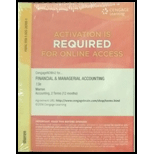
a)
Long-term debt: Long-term debt refers to the obligation of the company to be paid after one year or one operating cycle whichever is longer. Generally, the long-term debt is reported under the long-term liabilities section of the
Current portion of long-term debt: The amount of debt which would be paid within one year is called as current portion of long-term debt. The current portion of long-term debt is reported as a current liability.
To identify: The amount of long-term debt that was disclosed as a current liability on the current year’s December 31 balance sheet.
b)
The amount of change in total current liabilities between the preceding year and the current year as a result of the current portion of long-term debt.
c)
To identify: The amount of total long-term debt on December 31 of the upcoming year.
Want to see the full answer?
Check out a sample textbook solution
Chapter 10 Solutions
CengageNOWv2, 2 terms Printed Access Card for Warren?s Financial & Managerial Accounting, 13th, 13th Edition
 Managerial Accounting: The Cornerstone of Busines...AccountingISBN:9781337115773Author:Maryanne M. Mowen, Don R. Hansen, Dan L. HeitgerPublisher:Cengage LearningPrinciples of Accounting Volume 1AccountingISBN:9781947172685Author:OpenStaxPublisher:OpenStax College
Managerial Accounting: The Cornerstone of Busines...AccountingISBN:9781337115773Author:Maryanne M. Mowen, Don R. Hansen, Dan L. HeitgerPublisher:Cengage LearningPrinciples of Accounting Volume 1AccountingISBN:9781947172685Author:OpenStaxPublisher:OpenStax College Cornerstones of Financial AccountingAccountingISBN:9781337690881Author:Jay Rich, Jeff JonesPublisher:Cengage LearningCentury 21 Accounting Multicolumn JournalAccountingISBN:9781337679503Author:GilbertsonPublisher:Cengage
Cornerstones of Financial AccountingAccountingISBN:9781337690881Author:Jay Rich, Jeff JonesPublisher:Cengage LearningCentury 21 Accounting Multicolumn JournalAccountingISBN:9781337679503Author:GilbertsonPublisher:Cengage





